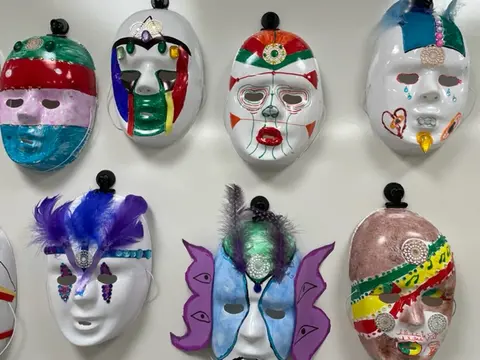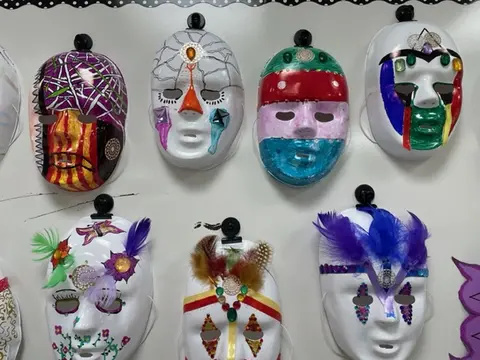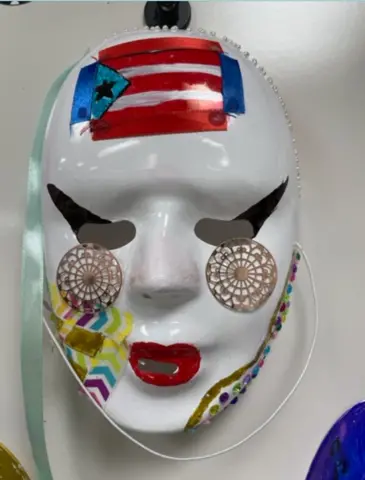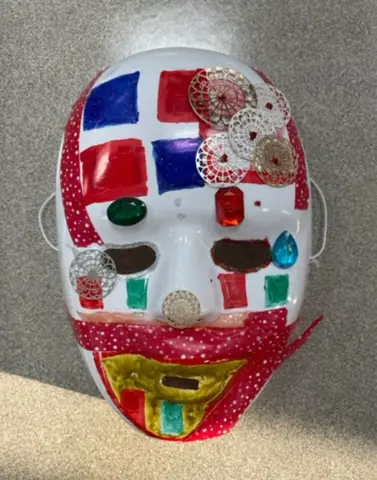This unit was created by educators in UBUNTU: High School for Law Advocacy and Community Justice, as part of the 2021 cohort of The 1619 Project Education Network. It is designed for facilitation across three-to-five days.
Objectives
Students will...
- Learn the geography and current capitals and countries of the African continent.
- Explore the hidden history of the masks in West Africa and Sub-Saharan Africa and their cultural significance.
- Create their own masks that reflect their lived experiences/hopes/culture/pride.
Essential Questions
- How can we challenge our geographic perceptions of the African continent?
- How are masks used historically/presently in West Africa and Sub-Saharan Africa?
- How can you create a mask that reflects your life experiences and culture?
- Why is consistent map-practice essential to understanding geography, history, and current events?
Unit Overview
As part of the core mission of The 1619 Project is revealing the hidden histories of the systematically excluded, this mini-unit returns to the source of humanity by exploring the geography of West Africa and creating masks in the spirit and essence of West Africa that represent the students’ lived experiences. This unit will introduce students to African geography and the culture of West Africa and Sub-Saharan Africa through mask-making and visual art.
Performance Task
Students will make a mask that represents themselves, their lived experiences, culture, hopes, dreams, aspirations, etc. Every mask should include...
- The agreed upon collective symbol to demonstrate that we are a community and accountable to one another.
- At least two colors that are symbolic to the individual student.
- At least one symbol that is meaningful to the individual student.
Three-to-five day unit plan for teachers, including pacing, texts and multimedia resources, worksheets, and performance task instructions. Download below, or scroll down to read the complete unit plan.
Unit Resources
| Resources from The 1619 Project | Born on the Water by Nikole Hannah-Jones and Renée Watson, illustrated by Nikkolas Smith |
| Student Readings | "The West African Mask," CulturesOfWestAfrica.com |
| Videos | Africa is NOT a Country, Iwani The Dama, Masked Dance of the Dogon, CulturesOfWestAfrica.com |
New York State Scope and Sequence for Social Studies 9-12:
- Individual Development and Cultural Identity
- Development Movement and Interaction of Cultures
- Time, Continuity and Change
- Geography, Humans and the Environment
Common Core Standards:
RL.11-12-.2 Determine a theme or central idea of a text and analyze in detail its development over the course of the text, including how it emerges and is shaped and refined by specific details; provide an objective summary of the text.
RL.11-12.3 Analyze how complex characters (e.g., those with multiple or conflicting motivations) develop over the course of a text, interact with other characters, and advance the plot or develop the theme.
RL.11-12.9 Analyze how an author draws on and transforms source material in a specific work (e.g., how Shakespeare treats a theme or topic from Ovid or the Bible or how a later author draws on a play by Shakespeare).
RI.11.12.7 Analyze various accounts of a subject told in different mediums (e.g., a person’s life story in both print and multimedia), determining which details are emphasized in each account.
SL.11.12.4 Present information, findings, and supporting evidence clearly, concisely, and logically such that listeners can follow the line of reasoning and the organization, development, substance, and style are appropriate to purpose, audience, and task.
W.11.12.1 Write arguments to support claims in an analysis of substantive topics or texts, using valid reasoning and relevant and sufficient evidence.
W.11.12.4 Write arguments to support claims in an analysis of substantive topics or texts, using valid reasoning and relevant and sufficient evidence.
Performance Task
Explore students' original masks reflecting their identities and culture below. These masks were created by students at UBUNTU: High School for Law Advocacy & Community Justice in fall 2021.
The author of this unit created a mini-grant on www.Donorschoose.org to fundraise for the necessary supplies for mask-making. Here is a link to the original Donorschoose page.






